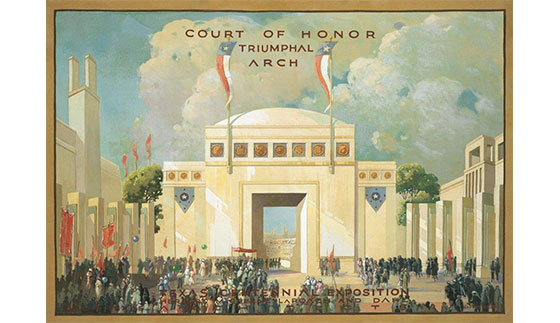Painting a vision for the Texas Centennial Exposition
'Court of Honor' on view at the Bullock Museum in Austin
June 24, 2016 (AUSTIN, TX) — An oil painting that helped Dallas clinch its role as the host city for the 1936 Texas Centennial Exposition is now on view at the Bullock Texas State History Museum in Austin.
Fair Park in Dallas, home of the annual State Fair of Texas, is known today for its iconic Art Deco architecture. But in 1934, when Dallas was selected as the central exposition site for the 1936 Texas Centennial celebration, Fair Park was limited to 80 acres and a handful of buildings.
A $25 million construction project, the vision of architect George L. Dahl, transformed the existing fairgrounds into a masterpiece worthy of a world's fair. A prominent architect, Dahl (1894–1987) came to Dallas in 1926. The Dallas committee seeking to win the bid for Texas's Centennial Exposition encouraged Dahl to develop an overall architectural concept for the fair. He was highly qualified for the job. In addition to his extensive architectural and design experience across the nation, Dahl had visited and studied several major expositions.
Dahl presented a series of speculative paintings to the Texas Centennial Commission on September 6, 1934. The color renderings were romanticized visions of the Centennial Exposition designed to showcase the potential of Dallas and Fair Park.
The paintings, including Court of Honor (1934), helped Dallas win the bid. Painted by artist Eugene Gilboe, the building in Court of Honor was never actually constructed. Once Dahl was appointed chief architect for the Texas Centennial Exposition, he hired Gilboe as his "colorist."
Gilboe was responsible for developing the very sophisticated architectural color and the lighting scheme for the exhibit buildings and exterior spaces that tied everything together. Gilboe was one of more than 8,000 workers Dahl supervised to develop 200 acres of exhibit buildings and infrastructure in nine months. A team of designers worked together to finalize Dahl's vision, a complex of Art Deco style buildings with smooth expanses of sun-colored walls, brightened with murals in bold colors and accented by massive sculpture.
Today the fairgrounds he created are on the National Register of Historic Places and are the largest concentration of public Art Deco buildings in the United States.
Court of Honor will be on view at the Bullock Museum through April 30, 2017 as part of its permanent galleries highlighting the 1936 Texas Centennial. The painting is on loan from the family of George Dahl: Ted and Gloria Akin, Adrienne Akin-Faulkner, Faulkner Design Group, Dallas. The Bullock Museum collaborates with more than 700 museums, libraries, archives and individuals to display original historical artifacts and host exhibitions that illuminate and celebrate Texas history and culture.
Visit TheStoryofTexas.com, or follow the Bullock Museum on Facebook and Twitter, to learn more about the museum's exhibitions, films and programs.
Support for the Bullock Museum's exhibitions and education programs provided by the Texas State History Museum Foundation.
Downloads
The Bullock Texas State History Museum, a division of the State Preservation Board and an accredited institution of the American Alliance of Museums, creates experiences that educate, engage, and encourage a deeper understanding of Texas. With dynamic, award-winning exhibitions that illuminate Texas history, people, and culture, educational programming for all ages, and an IMAX® theater with a screen the size of Texas, the Museum collaborates with more than 700 museums, libraries, archives, organizations, and individuals across the world to bring the Story of Texas to life. For more information, visit www.TheStoryofTexas.com
Media Contact
| General Inquiries | |
|---|---|
| 512-463-5424 | |
